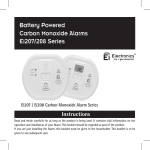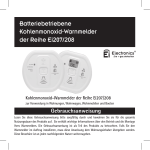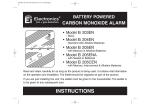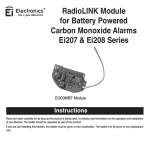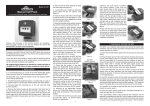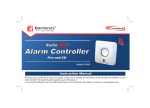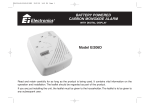Download Ei207-208-User-Manual
Transcript
Battery Powered Carbon Monoxide Alarms Ei207/208 Series Ei207 / Ei208 Carbon Monoxide Alarm Series Instructions Read and retain carefully for as long as the product is being used. It contains vital information on the operation and installation of your Alarm. The leaflet should be regarded as part of the product. If you are just installing the Alarm, the leaflet must be given to the householder. The leaflet is to be given to any subsequent user. Model Chart 2xAAA Replaceable Batteries RF Capability RF Module Supplied Ei207 No No No Ei207D No No Yes RF Capability RF Module Supplied LCD Display Ei208W Yes No No Ei208WRF Yes Yes No Ei208DW Yes No Yes Ei208DWRF Yes Yes Yes Model LCD Display Long Life Battery Built-in Model Table of Contents page 1. Read This First ................................................................... 2. Carbon Monoxide – The Silent Killer .................................. 3. Where to Place CO Alarms ................................................ 4. Installation .......................................................................... 5. Testing and Monitoring Your CO Alarm ............................... 6. What to do when the alarm sounds .................................... 7. Maintenance ....................................................................... 8. Limitations of CO Alarms .................................................... 9.How to Protect your Family ................................................. 10. Technical Specification ........................................................ 11. Getting the CO Alarm Serviced ........................................... 12. Guarantees ......................................................................... 13. Troubleshooting .................................................................. 14. LCD Display Symbols ......................................................... 15. Indicators Summary ............................................................ 16. Contact Us .......................................................................... 2. Location & Positioning 3 4 5 10 15 17 19 20 21 23 25 27 27 28 29 30 31 1. Read This First • Congratulations on becoming the owner of an Ei Carbon Monoxide Alarm. This will help protect you and your household from the dangerous effects of Carbon Monoxide- the silent killer. • The Carbon Monoxide Alarm (CO Alarm) is powered up by carefully rotating it onto the mounting plate which activates the on/off switch. The red, amber & green lights will immediately flash in sequence to show they are working. (For the Display models, the LCD screen will display all icons). Then wait 15 seconds after connecting the power before button testing. • Install a CO Alarm in every room that contains a fuel burning appliance, particularly rooms where people spend a lot of time e.g. bedrooms, kitchens and sitting rooms. • In rooms with an appliance, install (preferably) on the ceiling, (300mm from walls) and between 1m to 3m horizontally from appliance. In rooms remote from the appliance install at ‘head height’, where the light indicators can be seen. • Test the Alarm weekly by pressing the test/hush button, the horn will sound (at a diminished sound output level initially and then quickly reach maximum sound output level). • Replace Alarm after approx 6 years operation (see ‘Replace by’ date on side wall label). • Do not fit Alarm until all building work is completed to avoid contamination. 4 2. Carbon Monoxide – The Silent Killer Many people are killed each year, and many more suffer ill health from Carbon Monoxide (CO) poisoning. CO is an invisible, odourless, tasteless and extremely toxic gas. It is produced by appliances and vehicles burning fuels, such as coal, oil, natural/bottled gas, paraffin, wood, petrol, diesel, charcoal etc. CO is absorbed by red blood cells in the lungs in preference to oxygen - this results in rapid damage to the heart and brain from oxygen starvation. High levels of CO in a house can be caused by: • Incorrectly or poorly installed fuel-burning appliances. • Blocked or cracked chimneys/flues. • Blocked vents or draught-proofing which makes areas with fuel burning appliances or fireplaces airtight. • Engines of cars, lawnmowers etc. left running in confined spaces. • Portable paraffin or gas heaters in badly ventilated rooms. 2.2 Symptoms of Carbon Monoxide Poisoning Most people know that high levels of CO are harmful; however the period of exposure is also important. The following symptoms are related to Carbon Monoxide poisoning and should be discussed with all members of the household. 5 Carbon Monoxide – The Silent Killer 2.1 What is Carbon Monoxide ? Mild Exposure: Slight headache, nausea, vomiting, fatigue (often described as “flu-like” symptoms). Medium Exposure: Severe throbbing headache, drowsiness, confusion, fast heart rate. Extreme Exposure: Unconsciousness, convulsions, cardiorespiratory failure, death. A high level of CO for a short period (e.g. 350 ppm CO for 30 minutes) will cause the same symptoms, a slight headache, as a lower level for a longer time (e.g. 150 ppm for 90 minutes). Table A shows how exposure to different concentrations of CO generally affects people. Many cases of reported Carbon Monoxide poisoning indicate that while victims are aware they are not well, they become so disorientated that they are unable to save themselves by either leaving the building or calling for assistance. Young children and household pets may be the first affected. 2.3 What happens when your CO Alarm detects Carbon Monoxide ? When the Alarm detects potentially dangerous levels of CO, it flashes the red alarm light immediately and then sounds a loud alarm if the CO persists. Table B below shows how the CO Alarm reacts to different levels of CO gas and exposure time. At higher levels of CO the alarm turns on sooner. The rate of flashing of the red light indicates the level of CO. If your CO Alarm sounds follow the instructions on page 19. When ventilation is provided by leaving the window and doors open, the CO build up may have dissipated by the time help arrives and the alarm may have stopped sounding. Although your problem may appear temporarily solved it is crucial that the source of the CO is determined and appropriate repairs made. 6 Table A: Effects of Carbon Monoxide Poisoning Concentration of CO in Air ppm 35 Inhalation Time (approx) and Symptoms Developed The maximum allowable concentration for continuous exposure in any 8 hour period according to OSHA *. 150 Slight headache after 1.5 hours. 200 Slight headache, fatigue, dizziness, nausea after 2-3 hours. 400 Frontal headaches within 1-2 hours, life threatening after 3 hours, also maximum parts per million in flue gas (on an air free basis) according to US Environmental Protection Agency. 800 1,600 Dizziness, nausea and convulsions within 45 minutes. Unconsciousness within 2 hours. Death within 2-3 hours. Headache, dizziness and nausea within 20 minutes. Death within 1 hour. 3,200 Headache, dizziness and nausea within 5-10 minutes. Death within 25-30 minutes. 6,400 Headache, dizziness and nausea within 1-2 minutes. Death within 10-15 minutes. 12,800 Death within 1-3 minutes. ppm = parts per million *OSHA Occupational Safety & Health Association 7 Table B: CO Alarm Response Red Light (before horn sounds) (after horn sounds) Display Icon Horn / Sounder Display Icon CO Gas Level 0 < ppm < 30 ppm Off* Off Off Off 30 < ppm < 43 ppm Off* PPM level (steps of 5) PPM level (steps of 5) Off 43 < ppm < 80 ppm 1 flash every 2 secs 058 058 on within 60-90 mins (typ 72 mins) 80 < ppm < 150 ppm 1 flash every sec 102 102 on within 10-40 mins (typ 18 mins) > 150 ppm 2 flashes every sec 150 150 on within 2 mins (typ 40 secs) * unless it has alarmed previously (see CO Alarm Memory below) ppm values shown in table are for example purposes only 8 NEVER IGNORE THE ALARM. Pre-Alarm: When the Alarm detects over 43 ppm CO the red light flashes every 2 seconds. This helps locate CO leaks as the unit gives an indication straight away. (Without this feature the CO level would need to be at 43 ppm CO for typically 72 minutes for an alarm sound to be given). Note the Pre-Alarm signal may be triggered by CO coming for example, from cooking with gas, from car engines or from nearby barbecues. This is usually not a concern, unless the Pre-Alarm signal persists until the alarm sounds and the CO source is unknown. The Display Models will display the level of CO gas above 30 ppm. This is also an early warning indication that the CO gas level is building up and should be investigated. Above 43 ppm CO, the red light will also flash. NOTE: The CO Alarm may sound if cigarette smoke is blown into it, or aerosols are released nearby. CO ALARM MEMORY The CO Alarm memory is an important feature of the CO Alarm where even if the house is unoccupied during an alarm condition it warns the homeowner that the unit has previously detected CO gas and been in alarm. The memory is displayed via the flash rate of the red light. The red light will flash for a 24 hour period after an alarm event has stopped. After this period, the memory can be viewed by pressing and holding the test button (the flash rate will be as per Table B). The memory flash rate: The RED light will flash at different rates every 50 seconds depending on the level of CO detected as follows: - Red light flashes twice every 50 seconds, meaning that a CO level above 43 ppm has been detected and that the unit was previously in alarm. 9 - Red light flashes four times every 50 seconds, meaning that a CO level above 80 ppm has been detected and that the unit was previously in alarm. - Red light flashes eight times every 50 seconds, meaning that a CO level above 150 ppm has been detected and that the unit was previously in alarm. Reset Memory by holding down the test button for over 12 seconds until the red light stops flashing. Cover the horn with a cloth to muffle the alarm during this time. Please note that the memory will also be reset when the unit is switched off. 3. Where to Place CO Alarms 3.1 Ideally a Carbon Monoxide Alarm should be installed in: - Every room containing a fuel burning appliance, and - Remote rooms where occupants spend a considerable amount of time - Every bedroom. However if the number of Carbon Monoxide Alarms to be fitted is limited, the following points should be considered when deciding where best to fit the alarm(s) - If there is an appliance in a room where people sleep, place a CO Alarm in this room and - Locate a CO alarm in a room containing a flueless or open-flued appliance, and - Locate an alarm in a room where the occupant(s) spend most of their time (e.g. sitting room) and - In a bedsit, the CO alarm should be placed as far away from the cooking appliance as possible, but near to where the person sleeps and 10 - If the appliance is in a room not normally used, such as a boiler room, the CO alarm should be placed just outside the room so that the alarm will be heard more easily. Do not place the CO Alarm in any of the following areas. (1) In the immediate vicinity of a cooking appliance (keep it at least 1 metre horizontally from it). (2) Outside the building. (3) In an enclosed space (e.g. in or below a cupboard). (4) In a damp or humid area. (5) Directly above a sink or cooker. (6) Next to a door, window, air vent or anywhere that it would be affected by draughts. (7) Next to an extractor fan. (8) Over heat sources such as radiators or hot air vents. (9) Where it would be obstructed, e.g. by curtains or furniture. (10) In an area where the temperature could drop below –10°C or rise above 40°C. (11) Where dirt or dust could block the sensor. (12) Where it could be easily knocked or damaged, or where it could be accidentally turned off or removed. 11 Where to Place CO Alarms 3.2 Unsuitable Locations (13) In a bathroom or other areas where the CO alarm may be exposed to water splashes, dripping or condensation (e.g. above an electric kettle). (14) Near paint, thinners, solvent fumes or air fresheners. 3.31 If locating the CO alarm in a room with a fuel burning appliance (see figure 1) • If it is mounted on a wall, it should be located at a height greater than the height of any door or window but still be at least 150mm from the ceiling. • If it is mounted on the ceiling it should be at least 300mm from any wall or light fitting. • The CO alarm should be a horizontal distance of between 1m and 3m from the potential CO source. • If there is a partition in the room, the CO alarm should be located on the same side of the partition as the potential source. • In rooms with sloped ceilings, the CO alarm should be located at the high side of the room (see fig 2). 3.32 If locating the CO alarm in a bedroom or in rooms remote from a fuel burning appliance (see figure3) • Mount the CO alarm relatively close to the breathing zone of the occupants. Whatever position is chosen make sure it is possible to view the three light indicators, when in the vicinity of the alarm. WARNING: Do not use the CO Alarm on an intermittent basis, or as a portable detector for the leakage of combustion products from fuel burning appliances or chimneys. 12 300mm CO Alarm 150mm 1 to 3 m DEAD AIR DON'T LOCATE HERE 1 to 3 m Figure 1 Location in room with a fuel burning appliance 13 300 mm CO Alarm CO Alarm about 1 to 2m Figure 2 Location in rooms with sloped ceilings, the CO alarm should be located at the high side of the room 14 Figure 3 Location in bedrooms & other rooms remote from the appliance (i.e. at breathing level) 4. Installation 1. Select a location complying with the advice in Section 3. 2. Remove the mounting plate from the packaging/Alarm. 3. Place the mounting plate on the ceiling/wall exactly where you want to mount the Alarm. With a pencil, mark the location of the two screw holes. 4. Taking care to avoid any electrical wiring in the ceiling, drill holes using a 5.0mm drill bit through the centre of the marked locations. Push the plastic screw anchors provided into the drilled holes. Screw the mounting plate to Figure 4 the ceiling/wall. 5. Alternatively, if desired, the CO Alarm will also free stand on a flat surface with the mounting plate attached. 6. If using the RadioLINK interconnection, ensure the RF module is fitted correctly into the base of the Alarm. For further advice on the RadioLINK installation, see booklet “RadioLINK Module for Battery Powered Carbon Monoxide Alarms”. 7. Carefully line up the Alarm on the base, gentle press home & twist on – see figure 4. (This connects the batteries). The red, amber & green lights will 15 Installation 4.1 Installation Procedure immediately flash in sequence to show they are working. In addition, the icons on the LCD display on the Display models will also light up. 8. Press the Test button (after 15 seconds) to ensure that the Alarm works (see figure 5). 9. Install all the other Alarms similarly. 4.2 How to Tamperproof the Alarm The Alarm can be made resistant to unauthorised removal. Break off the small pillar on the base as shown in figure 6a. To remove the Alarm from the ceiling it is now necessary to use a small screwdriver, to release the catch (push catch towards the ceiling) and then twist off the Alarm (see figure 6b). Figure 6a Figure 6b 16 Red Light Amber Light Green Light Test Button Figure 5 Figure 7 5. Testing and Monitoring Your CO Alarm Button Test It is recommended that you test your CO Alarm after installation (wait 15 seconds after connecting the power) and then once a week to make sure the Alarm is working. It will also help you and your family to become familiar with the sound of the Alarm. Press and hold the test button (see figure 5) until the Alarm sounds (it may take up to 5 seconds) and the green light flashes. (For Display models, the LCD will also display the “OK status” icon). The audible alarm will sound at a diminished sound output level initially and then quickly reach maximum sound output level. The Alarm will stop sounding shortly after the button is released. Low Battery Indicator If the Alarm beeps and the green and amber lights flash simultaneously every 50 seconds, then the batteries are depleted. (For Display models, the LCD will also display the “Low Battery status” icon). (For Ei207 Models Only) Check the ‘Replace by’ label on the side wall - if it has been exceeded replace the entire unit. If the Replace by’ label on the side wall has not been exceeded, remove the Alarm from the mounting plate, remove the battery cover (see figure 8) and replace the batteries. Use only the following Alkaline AAA size batteries: Duracell, Panasonic, or Energizer. 17 Testing and Monitoring Your CO Alarm If necessary it is possible to further secure or tamperproof the Alarm by using a No.2 or No.4 (2 to 3mm diameter - not supplied) self tapping screw 6 to 8mm long to firmly lock the Alarm and its mounting plate together (see figure 7). Insert the new batteries with the orientation shown on the base. Replace the battery cover and replace the Alarm back on its mounting plate (this action automatically switches on the batteries). Button test the Alarm (after 15 seconds) to check the batteries are installed correctly and that they are not depleted. (For Ei208 Models Only) These alarms use long-life lithium batteries and are not replaceable. Check the ‘Replace by’ label on the side wall - if it has been exceeded replace the entire unit. If the ‘Replace by’ date has not been exceeded, then the Alarm maybe faulty and needs to be returned to the manufacturer – See “Getting the CO Alarm Serviced Page 27)”. Figure 8 Amber Fault Indicator with Beep If the Alarm beeps and the amber light flashes simultaneously every 50 seconds the self-checking circuitry may have detected a fault. This Alarm is probably defective and must be replaced. See “Getting the CO Alarm Serviced Page 27)”. End-of-life Indicator When the unit has completed approx 6 years of operation the amber light will flash twice every 50 seconds without a corresponding beep. This indicates that the Alarm has reached its end-of-life. (For Display models, the LCD will also display the “REPLACE UNIT”). 18 For environmentally sound disposal, remove the Alarm from its mounting plate (for Ei207 models, open the battery door and remove the batteries) and dispose in accordance with best practice and guidance on WEEE disposal and recycling. Testing with Carbon Monoxide The Alarm can be tested with carbon monoxide gas by using one of the kits that comes with the gas either in a glass phial or aerosol can. Follow the instructions on the kit. It is best if possible to inject the CO gas into the gas entry holes, see Figure 9. When it senses the CO, it flashes the red light (as per Table B) to confirm that its detecting CO gas. Gas entry holes Figure 9 6. What to do when the alarm sounds (1) Open the doors and windows to ventilate the area. (2) Turn off all fuel appliances where possible and stop using them. (The Alarm can be silenced immediately by pushing the test/hush button). (3) Evacuate the property leaving the doors and windows open. 19 What to do when the alarm sounds Check the ‘Replace by’ label on the side wall - if it has been exceeded replace the entire unit. If the ‘Replace by’ date has not been exceeded, then the Alarm may be faulty and needs to be returned to the manufacturer – See “Getting the CO Alarm Serviced Page 27)”. (4) Get medical help immediately for anyone suffering the effects of Carbon Monoxide poisoning (headache, nausea), and advise that Carbon Monoxide poisoning is suspected. (5) Ring your gas or other fuel supplier on their emergency number. Keep the number in a prominent place. (6) Do not re-enter the property until the alarm has stopped. (If the alarm has been silenced by pressing the test/hush button, wait at least 5 minutes so the Alarm can check that the CO has cleared). Maintenance (7) Do not use the fuel appliances again until they have been checked by a registered installer or equivalent expert. 7. Maintenance Clean the outside case by occasionally wiping with a clean damp cloth. Do not use any cleaning agents, bleaches, detergents or polishes, including those in aerosol cans. Avoid spraying air fresheners, hair spray, paint or other aerosols near the CO Alarm. Do not place air fresheners near the unit. Use the narrow nozzle of a vacuum cleaner to remove fluff and other contamination from the cover slots and gas entry holes. Caution: Do not paint the CO Alarm. Remove the CO Alarm when decorating. Do not allow water or dust to contaminate the Alarm. Warning: Do not open or tamper with the CO Alarm. There are no user serviceable parts inside and this can damage the Alarm. 20 8. Limitations of CO Alarms (2) Carbon Monoxide must enter the unit for it to be detected. There may be Carbon Monoxide in other areas of the house (e.g. downstairs, in a closed room etc) but not in the vicinity of the CO Alarm. Doors, air draughts and obstructions can prevent the CO reaching the Alarm. For these reasons we recommend CO Alarms are fitted both near and in bedrooms, particularly if bedroom doors are closed at night. Additionally install in rooms where members of the household spend much of their time, and in rooms with potential sources of CO gas. (3) The CO Alarm may not be heard. The sound output is loud but it may not be heard behind a closed door or if it is too far away. RF interconnecting CO Alarms greatly improves the probability that they will be heard. The Alarm may not wake up somebody who has taken alcohol or drugs. The alarm sound may be masked by other sounds such as T.V., stereo, traffic noise etc. Fitting CO Alarms on either side of closed doors will improve their chance of being heard. This CO Alarm is not designed for people with impaired hearing. (4) CO Alarms don’t last indefinitely. CO Alarms are sophisticated electronic devices with many parts. Although the Alarm and its component parts have undergone stringent tests, and are designed to be very reliable, it is possible that parts can fail. Therefore, you should test your CO Alarm weekly. The CO Alarm must be replaced after 6 years of operation. 21 Limitations of CO Alarms (1) The CO Alarm will not work without good batteries. If the batteries have been drained the Alarm will not give protection. Button test the Alarm weekly and on return from holidays and other long absences. (5) CO Alarms are not a substitute for life insurance. House-holders are responsible for their own insurance. The CO Alarm warns of increasing CO levels, but we do not guarantee that this will protect everyone from CO poisoning. (6) CO Alarms are not suitable as early warning Smoke Alarms. Some fires produce Carbon Monoxide, but the response characteristics of these CO Alarms are such that they would not give sufficient warning of fire. Smoke Alarms must be fitted to give early warning of fire. (7) The CO Alarm does not detect the presence of natural gas (methane), bottled gas (propane, butane) or other combustible gases. Fit combustion Gas Alarms to detect these. Note: Carbon Monoxide Alarms, with electrochemical sensors have a cross sensitivity to hydrogen. This means that they can alarm due to sensing hydrogen being produced by batteries being incorrectly charged such as on boats or with battery back-up systems such as those used with alternative energy systems. The unit will alarm with 500 ppm H2 after between 10 and 40 minutes exposure. WARNING: THIS CO ALARM IS DESIGNED TO PROTECT INDIVIDUALS FROM THE ACUTE EFFECTS OF CARBON MONOXIDE EXPOSURE. IT WILL NOT FULLY SAFEGUARD INDIVIDUALS WITH SPECIFIC MEDICAL CONDITIONS. IF IN DOUBT CONSULT A MEDICAL PRACTITIONER. 22 9. How to Protect your Family Follow these guidelines to reduce the risk of Carbon Monoxide poisoning. (1) Know and look out for tell-tale signs that Carbon Monoxide may be present. - The CO Alarm warning of abnormal levels. - Staining, sooting or discolouration on or around appliances. - A pilot light frequently going out. - A strange smell when an appliance is operating. - A naked gas flame which is yellow or orange, instead of the normal blue. - Family members (including pets) exhibiting the “flu-like” symptoms of CO poisoning described above. If any of these signs are present get the appliance checked out by an expert before further use. If family members are ill get medical help. (2) Choose all appliances and vehicles which burn fossil fuels such as coal, oil, natural/bottled gas, paraffin, wood, petrol, diesel, charcoal etc. with care and have them professionally installed and regularly maintained. (3) These appliances must “breathe in” air to burn the fuel properly. Know where the air comes from and ensure vents/air bricks etc. remain unobstructed (particularly after building work). (4) The appliances must also “breathe out” the waste gases (including the CO) – usually through a flue or chimney. Ensure chimneys and flues are not 23 How to Protect your Family These include:- blocked or leaking, and get them checked every year. Check for excessive rust or cracks on appliances and pipe work. (5) Never leave your car, motor bike or lawnmower engine running in the garage with the garage door closed. Never leave the door from the house to the garage open if the car is running. (6) Never adjust your own gas pilot lights. (7) Never use a gas cooker or a barbecue for home heating. (8) Children should be warned of the dangers of CO poisoning and instructed never to touch, or interfere with the CO Alarm. Do not allow small children to press the test/hush button as they could be subjected to excessive noise when the unit alarms. (9) Leaving windows or doors slightly open (even a few inches) will significantly reduce the risk of high levels of CO occurring. The high levels of draught-proofing in modern houses reduces ventilation and can allow dangerous gases to build up. (10) Install CO Alarms in all the areas recommended in this booklet. (11) Recognise that CO poisoning may be the cause when family members suffer from “flu-like” symptoms when at home but feel better when they are away for extended periods. 24 10. Technical Specification Power : Two Alkaline AAA type batteries (replaceable) – Ei207 models One long life lithium battery (non-replaceable) – Ei208 models Electromagnetic Compatibility : Complies with BS EN 50270 Test/Hush Button : Checks electronics and horn. When the unit is alarming, after sensing CO, pressing the test/hush button will immediately stop the horn (the red light will continue to flash). If CO is still present the red light and the horn will turn on again after about 4 minutes. The unit can only be silenced once during a CO incident. At 300ppm CO the unit cannot be silenced. Testing with CO : The red light flashes (as per Table B) almost immediately after exposure to CO gas. Display Models will display CO ppm level above 30ppm. Initialisation Time : 20 seconds. On power up red, amber and green lights flash momentarily to show they are operational. (Display Models will display all icons on the LCD screen). Operating Temperature : -10°C to 40°C Humidity Range : 15% to 95% R.H. (non-condensing) Audible Alarm : 85dB(A) at 3m minimum 25 Technical Specification CO Sensitivity : Meets BS EN 50291:2001 Unit operates as per Table B (on page 8). Self Diagnostics : Horn beep and amber fault light flashes twice a second every 50 seconds if a sensor fault is found. Tamperproof : Available RF Interconnect : Available with RF upgradeable Alarms and RF module only. CO Alarm Memory: An Alarm will indicate if it has been in alarm previously by flashing the red light. (The Display Models will also display the level of CO in ‘ppm’). The number of flashes per minute will indicate the range of CO detected and will last for 24 hours. The memory can also be recalled by pressing and holding the test button down. The memory will be erased by holding the button down for over 12 seconds. Low Battery Indication: Amber and green light flashes once every 50 seconds with simultaneous alarm beep. (Display Models will also display the “Battery Status” icon on the LCD screen). Fault Indication: Amber light flashes twice per second every 50 seconds with simultaneous alarm beep. (Display Models will also display the “Replace Unit” on the LCD screen). End of Life Indication: Amber light flashes twice per second every 50 seconds (Display Models will also display the “Replace Unit” on the LCD screen). Dimensions : 120mm x 105mm x 40mm Weight : 185g (Ei207) 178g (Ei208) 26 If your CO Alarm fails to work after you have carefully read all the instructions, checked the unit has been installed correctly, and ensured that it has good batteries connected, return it for repair or replacement. This should be where it was purchased, or alternatively return it in a padded box to “Customer Assistance and Information” at the nearest address given on the CO Alarm or in this leaflet. (Remove the Alarm from the mounting plate before shipping the product). State the nature of the fault, where the CO Alarm was purchased, and the date of purchase. 12. Guarantee Ei Electronics guarantees Carbon Monoxide Alarms Models Ei207 (excluding batteries) & Ei208 for five years from date of purchase against any defects that are due to faulty materials or workmanship. These guarantees only apply to normal conditions of use and service, and do not include damage resulting from accident, neglect, misuse, unauthorised dismantling, or contamination howsoever caused. These guarantees exclude incidental and consequential damage. If the Carbon Monoxide Alarm should become defective within the guarantee period, it must be returned to where it was purchased or alternatively to Ei Electronics, carefully packaged, with the problem clearly stated (see section 11 “Getting the CO Alarm Serviced”) along with proof of the date of purchase. We shall at our discretion repair or replace the faulty unit. 27 Getting the CO Alarm Serviced / Guarantee 11. Getting the CO Alarm Serviced 13. Troubleshooting ALARM DOES NOT WORK WITH THE TEST BUTTON: (1) Wait 15 seconds after connecting the power before button testing. (2) Hold button down firmly for at least 5 seconds. (3) Check the Alarm is secured correctly on the mounting plate. (4) Replace batteries (Ei207 models only). Troubleshooting ALARM SOUNDS FOR NO APPARENT REASON: Follow the detailed instructions in Section 6 Entitled “What to do when the alarm sounds” (page 19). If there are still problems: (1) Ensure there are no fuel burning appliances in the vicinity which could be leaking CO gas (e.g. even from next door). (2) Ensure there are no fumes in the area (e.g. paint, thinners, hair spray, chemical cleaners aerosol sprays etc). (3) Ensure there is no outdoor source of CO in the vicinity (e.g. a car with engine running, heavy traffic, heavy air pollution, barbecue fumes etc). (4) Ensure there is no source of hydrogen such as batteries being charged (e.g. on boats or in Uninterruptable Power Supplies (UPS)). (5) Ensure there is not excessive smoke or fumes from devices such as Egyptian shisha, hookah or hubbly bubbly pipes, especially those that use coal or charcoal to heat the tobacco. 28 (6) If the Alarm is fitted with an RF Module, ensure that there are no problems with the other RF interconnected Alarms and that all Alarms are housecoded correctly. (7) Press the test/hush button to silence the alarm. If the unit continues to sound it is possibly defective and should be replaced (see section 11 “Getting the CO Alarm Serviced”). 14. LCD Display Symbols Low Battery Warning Sensor Fault Ventilate Status Evacuate Status End of Life Status 058 102 Button Test OK 000 29 15. Indicators Summary Mode 1 2 Normal Power Up Button Test (Weekly) Alarm Mode Unit Sensing CO gas itself 3 4 Sensing CO through RF interconnect Hush Mode (unit sensing CO gas) Press Test Button Low Battery Mode Low Battery Condition 5 Press Test Button Sensor Fault Mode Sensor Fault Condition Press Test Button 6 7 End of Life Mode RED LIGHT AMBER LIGHT GREEN LIGHT SOUNDER Off Off Off Off Off Flashing (every sec) Ramps up to full sound Off Off Full Sound Off Off Full Sound Flashing (as per table B) Off Off Off for 4 minutes Off 1 flash (every 50 secs) 1 flash (every 50 secs) 1 beep with flash 1 flash (every sec) 2 flashes (every sec) Ramps up to full sound 2 flashes (every 50 secs) Off 1 beep with flash 1 flash (every sec) Off Off 1 flash 1 flash Off Flashing (as per table B) Off Off Off Off 1 flash Off End of Life Condition Off 2 flashes (every 50 secs) Off Off Press Test Button Off 1 flash (every sec) Off Ramps up to full sound Flashing (as per table B) for 24 hours Off Off Off Flashing (as per table B) Off Off Ramps up to full sound Will initially flash and then go off Off Off Ramps up to full sound Troubleshooting Diagnostics Memory Alarm previously sensed CO Press Test Button Memory Erase Press Test Button (& hold for >12 seconds) 30 16. Contact Us Aico Ltd. Mile End Business Park, Maesbury Rd, Oswestry, Tel: 0870 758 4000 www.aico.co.uk Ei Electronics. Shannon, Co Clare, Ireland. Tel: 061 471277 www.eielectronics.com 31 Contact Us Shropshire SY10 8NN, U.K. Block E1 The crossed out wheelie bin symbol that is on your product indicates that this product should not be disposed of via the normal household waste stream. Proper disposal will prevent possible harm to the environment or to human health. When disposing of this product please separate it from other waste streams to ensure that it can be recycled in an environmentally sound manner. For more details on collection and proper disposal, please contact your local government office or the retailer where you purchased this product. © Ei Electronics 2011 P/N B17090 Rev 0
































